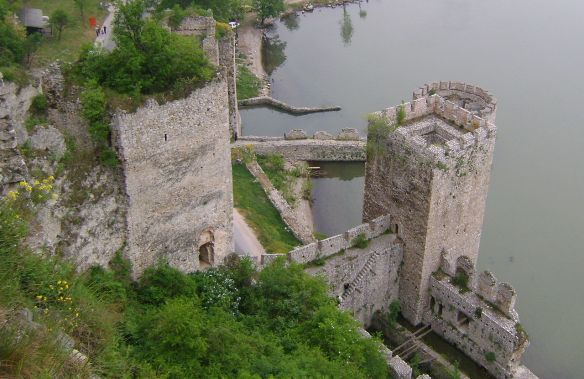Golubac consists of three main compounds guarded by 10 towers and 2 portcullises, all connected by fortress walls 2–3 meters thick. In front of the fortress, the forward wall (I) doubled as the outer wall of the moat, which connected to the Danube and was likely filled with water. A settlement for common people was situated in front of the wall.
As is the case with many fortresses, Golubac’s structure was modified over time. For years, there were only five towers. Later, four more were added. The towers were all built as squares, a sign of the fortress’ age, showing that battles were still fought with cold steel. Once firearms came into use, the Turks fortified the western towers with cannon ports and polygonal or cylindrical reinforcements up to two meters thick. After the Hungarian raid in 1481, they added the final tower, complete with cannon embrasures and galleries.
Topographical sketch of Golubac Fortress prior to 1972 (symbols referenced in the text)
Upper compound
The upper compound (A) is the oldest part of the fortress. It includes the citadel (tower 1) and the Serbian Orthodox chapel (tower 4). Although it remains uncertain, the chapel has led many to believe that this section was built by a Serbian noble.
Later, during either Serbian or Hungarian rule, the fortress was expanded to include the rear and forward compounds.
Rear compound
The rear compound (D) is separated from the upper compound by both a wall connecting towers 2 and 4, and a steep rock 3–4 meters high. Next to tower 5 is a building (VII) which was probably used as a military barracks and for ammunition storage.
Forward compound
The forward compound was split into lower (C) and upper (B) parts by a wall linking towers 4 and 7. The entrance (II) is in the lower part, guarded by towers 8 and 9. Tower 8 has, in turn, been fortified with a cannon port. Opposing the entrance was a second portcullis that led to the rear compound. Along the path was a ditch 0.5 meters wide and 0.75 meters deep which then became a steep decline. At the outer end of the lower part, and connected to the 9th tower with a low wall, is tower 10, which the Turks added to act as a lower artillery tower. It controlled passage along the Danube and guarded the entrance to the harbor, which was probably situated between towers 5 and 10. There are remains connected to tower 8 which probably formed a larger whole with it, but the lower part did not otherwise contain buildings.
In the wall that separated the upper and lower parts was a gate that led to the upper part. The upper part did not have buildings, but there remains a pathway to the stairs up to gate IV, which is 2 meters off the ground, right next to tower 3.
Towers
The first nine towers are 20–25 meters high. In all ten towers, the floors and stairs inside were made of wood, while external stairs were made of stone. Half of the towers (1, 2, 4, 5, 10) have all four sides and are completely made of stone, while the other half (3, 6, 7, 8, 9) lack the side facing the interior of the fort.
Tower 1, nicknamed “Hat Tower” (Šešir-kula), is one of the oldest towers, and doubles as citadel and dungeon tower. It has an eight-sided base with a circular spire rising from it and a square interior. The next tower to the west, tower 2, is completely circular in shape. The third tower has a square base, with the open side facing the dungeon tower to the north. On the top floor is a terrace that overlooks the Danube and the entrance to the Iron Gate gorge. Down the slope from tower 3 is tower 4, which also has a square base. The ground floor has a Serbian Orthodox chapel that was built into the tower, rather than being added later. The last tower along this wall, tower 5, is the only tower to remain completely square.
The top tower along the front wall of the forward compound, tower 6, has a square base which was reinforced with a six-sided foundation. Working west, the square base of tower 7 was reinforced with a circular foundation. Tower 8, on the upper side of the front portcullis, has an irregular, but generally square, base. It is also the shortest of the first nine towers. Guarding the other side is tower 9, which has a square base reinforced by an eight-sided foundation.
The last tower is the cannon tower. It has only one floor and is the shortest of all ten towers. It was built with an eight-sided base and cannon ports to help control traffic on the Danube. Tower 10 is almost identical to the three artillery towers added to Smederevo fortress.
